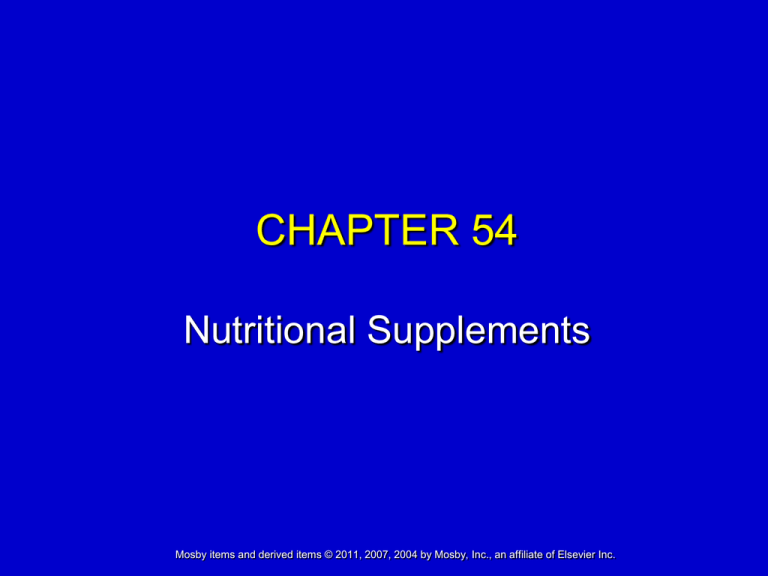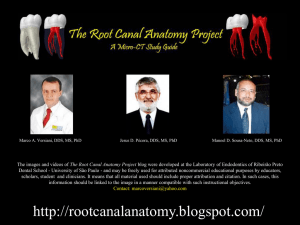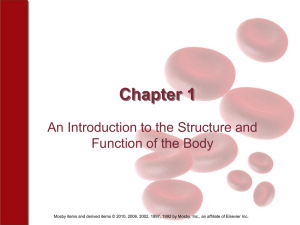Chapter_54
advertisement

CHAPTER 54 Nutritional Supplements Mosby items and derived items © 2011, 2007, 2004 by Mosby, Inc., an affiliate of Elsevier Inc. Nutrition Supplements Dietary products used to provide nutritional support Can be given in a variety of ways Vary in amounts and complexity of carbohydrates, protein, and fat content Electrolytes, vitamins, minerals, and osmolality may also vary Mosby items and derived items © 2011, 2007, 2004 by Mosby, Inc., an affiliate of Elsevier Inc. 2 Nutrition Supplements (cont’d) Malnutrition Enteral nutrition The body’s nutritional needs are not met by nutrient intake Provision of food or nutrients through the GI tract Parenteral nutrition Delivery of nutrients directly into the circulation by means of an intravenous solution Mosby items and derived items © 2011, 2007, 2004 by Mosby, Inc., an affiliate of Elsevier Inc. 3 Enteral Nutrition Provision of food or nutrients through the GI tract Oral consumption is the most common and least invasive route Feeding tubes through various routes can be used for enteral nutrition Mosby items and derived items © 2011, 2007, 2004 by Mosby, Inc., an affiliate of Elsevier Inc. 4 Mosby items and derived items © 2011, 2007, 2004 by Mosby, Inc., an affiliate of Elsevier Inc. 5 Enteral Nutrition (cont’d) Feeding tubes are used for those with: Abnormal esophageal or stomach peristalsis Altered anatomy secondary to surgery Depressed consciousness Impaired digestive capacity Mosby items and derived items © 2011, 2007, 2004 by Mosby, Inc., an affiliate of Elsevier Inc. 6 Enteral Formulation Groups Provide basic building blocks for anabolism Supply complete dietary needs through the GI tract by oral route or by feeding tube Elemental Polymeric Modular • Carbohydrate formulations • Fat formulations • Protein formulations Altered amino acid formulations Impaired glucose tolerance Mosby items and derived items © 2011, 2007, 2004 by Mosby, Inc., an affiliate of Elsevier Inc. 7 Enteral Formulation Group: Elemental Vivonex Plus, Peptamen, Vital HN Minimal digestion needed; residual is minimal Used for pancreatitis, partial bowel obstruction, irritable bowel disease, other conditions Hyperosmolarity of formulas may cause GI problems Mosby items and derived items © 2011, 2007, 2004 by Mosby, Inc., an affiliate of Elsevier Inc. 8 Enteral Formulation Group: Polymeric Ensure, Ensure-Plus, Isocal, Osmolite, Sustacal, Jevity, others Preferred over elemental formulations for patients with fully functional GI tracts and few specialized nutrient requirements; cause fewer GI problems Most closely resemble normal dietary intake Mosby items and derived items © 2011, 2007, 2004 by Mosby, Inc., an affiliate of Elsevier Inc. 9 Enteral Formulation Group: Modular Three types Carbohydrate: Moducal, Polycose Fat: MCT oil, Microlipid Protein: Casec, ProMod Single nutrient formulas Intended for use with monomeric or polymeric formulations Mosby items and derived items © 2011, 2007, 2004 by Mosby, Inc., an affiliate of Elsevier Inc. 10 Enteral Formulation Group: Altered Amino Acid Amin-Aid, Hepatic-Aid, Travasorb Renal, Traum-Aid HBC Contain varying amounts of specific amino acids Used for patients with diseases associated with altered metabolism capabilities Mosby items and derived items © 2011, 2007, 2004 by Mosby, Inc., an affiliate of Elsevier Inc. 11 Enteral Formulation Group: Impaired Glucose Tolerance Glucerna Contains proteins, carbohydrates, fat, sodium, potassium Used in patients with impaired glucose tolerance (e.g., diabetic patients) Mosby items and derived items © 2011, 2007, 2004 by Mosby, Inc., an affiliate of Elsevier Inc. 12 Enteral Nutrition: Interactions Various nutrients can interact with drugs to produce significant food-drug interactions Enteral nutrition can delay absorption of some medications Enteral nutrition may inactivate some medications (e.g., tetracycline and nutrient formulations that contain calcium) Mosby items and derived items © 2011, 2007, 2004 by Mosby, Inc., an affiliate of Elsevier Inc. 13 Parenteral Nutrition Totally digested nutrients are given intravenously, directly into the circulatory system The entire GI system is bypassed, eliminating the need for absorption, metabolism, or bowel elimination Mosby items and derived items © 2011, 2007, 2004 by Mosby, Inc., an affiliate of Elsevier Inc. 14 Parenteral Nutrition (cont’d) Also known as total parenteral nutrition (TPN) or hyperalimentation Formulations vary according to individual patient nutritional needs Amino acids Carbohydrates Lipids Trace elements Mosby items and derived items © 2011, 2007, 2004 by Mosby, Inc., an affiliate of Elsevier Inc. 15 Parenteral Nutrition (cont’d) Amino acids Nonessential amino acids Essential amino acids Semi-essential amino acids Trace elements Chromium Iodine Copper Manganese Mosby items and derived items © 2011, 2007, 2004 by Mosby, Inc., an affiliate of Elsevier Inc. 16 Mosby items and derived items © 2011, 2007, 2004 by Mosby, Inc., an affiliate of Elsevier Inc. 17 Mosby items and derived items © 2011, 2007, 2004 by Mosby, Inc., an affiliate of Elsevier Inc. 18 Parenteral Nutrition (cont’d) Peripheral total parenteral nutrition Temporary, short term (less than 2 weeks) Dextrose concentration generally less than 10% Central total parenteral nutrition Long-term use (over 2 weeks) Dextrose concentrations may be 10% to 50%, but are commonly 25% to 35% Mosby items and derived items © 2011, 2007, 2004 by Mosby, Inc., an affiliate of Elsevier Inc. 19 Peripheral TPN Used to provide nutrients to patients who need more nutrients than present oral intake can provide Indicated for: Procedures that restrict oral feedings Anorexia caused by chemotherapy or radiation treatments GI illnesses that prevent oral food intake Postsurgical patients When nutrition deficits are minimal, but oral nutrition will not be started for more than 5 days Mosby items and derived items © 2011, 2007, 2004 by Mosby, Inc., an affiliate of Elsevier Inc. 20 Peripheral TPN: Adverse Effects Phlebitis is the most devastating adverse effect Can lead to loss of a limb Fluid overload Mosby items and derived items © 2011, 2007, 2004 by Mosby, Inc., an affiliate of Elsevier Inc. 21 Central TPN Delivered through a large central vein Subclavian Internal jugular Long-term use (more than 2 weeks) Mosby items and derived items © 2011, 2007, 2004 by Mosby, Inc., an affiliate of Elsevier Inc. 22 Central TPN (cont’d) Disadvantages are the risks associated with central line insertion, use, and maintenance Higher risk for infection, catheter-induced trauma, metabolic alterations Mosby items and derived items © 2011, 2007, 2004 by Mosby, Inc., an affiliate of Elsevier Inc. 23 Central TPN (cont’d) Delivers total dietary nutrients to patients who require nutritional supplementation Patients with large nutritional requirements (metabolic stress or hypermetabolism) Patients who need nutritional support for more than 2 weeks Patients who are unable to tolerate large fluid loads Mosby items and derived items © 2011, 2007, 2004 by Mosby, Inc., an affiliate of Elsevier Inc. 24 Central TPN: Adverse Effects Most common are those surrounding the use of the central line for the delivery of TPN Infection Catheter-induced trauma Greater chance for hyperglycemia because of the larger and more concentrated volumes given Mosby items and derived items © 2011, 2007, 2004 by Mosby, Inc., an affiliate of Elsevier Inc. 25 Nursing Implications Ensure that a complete nutritional assessment is taken, including a dietary history, weekly and daily food intakes, and weight and height measurements Consult with a registered dietitian Mosby items and derived items © 2011, 2007, 2004 by Mosby, Inc., an affiliate of Elsevier Inc. 26 Nursing Implications (cont’d) Assess baseline laboratory studies, such as total protein, albumin, BUN, RBC, WBC, cholesterol, and so on Collect anthropometric data Assess for allergies to components of enteral nutritional supplements (such as whey, egg whites) Assess for lactose intolerance Mosby items and derived items © 2011, 2007, 2004 by Mosby, Inc., an affiliate of Elsevier Inc. 27 Nursing Implications (cont’d) If administering enteral nutrition by tube feedings, follow facility policy for ensuring proper tube placement and for checking residual before giving a feeding Follow procedures for flushing tubing to prevent clogging the feeding tube with formula Mosby items and derived items © 2011, 2007, 2004 by Mosby, Inc., an affiliate of Elsevier Inc. 28 Nursing Implications (cont’d) Carefully monitor how the patient is tolerating enteral feedings Keep in mind that most enteral feedings are started slowly, and the rate is increased gradually Monitor for signs of lactose intolerance Cramping Diarrhea Abdominal bloating Flatulence Mosby items and derived items © 2011, 2007, 2004 by Mosby, Inc., an affiliate of Elsevier Inc. 29 Nursing Implications (cont’d) Follow facility policies and procedures for care and maintenance of TPN IV lines, including tubing and dressing changes Monitor patient’s temperature; report any increase immediately Mosby items and derived items © 2011, 2007, 2004 by Mosby, Inc., an affiliate of Elsevier Inc. 30 Nursing Implications (cont’d) Monitor blood glucose levels with a glucometer Monitor for hyperglycemia Headache, dehydration, weakness Monitor for hypoglycemia Cold, clammy skin, dizziness, tachycardia, tingling of the extremities Mosby items and derived items © 2011, 2007, 2004 by Mosby, Inc., an affiliate of Elsevier Inc. 31 Nursing Implications (cont’d) While on TPN, the pancreas provides increased amounts of insulin to cover the increased glucose levels If TPN is discontinued abruptly, rebound hypoglycemia may occur until the pancreas has time to adjust to changing glucose levels If TPN must be discontinued abruptly, then infuse 5% to 10% glucose to prevent hypoglycemia Mosby items and derived items © 2011, 2007, 2004 by Mosby, Inc., an affiliate of Elsevier Inc. 32 Nursing Implications (cont’d) Monitor for fluid overload while on TPN Weak pulse Hypertension Tachycardia Confusion Decreased urine output Pitting edema Monitor daily weights and intake and output volumes Mosby items and derived items © 2011, 2007, 2004 by Mosby, Inc., an affiliate of Elsevier Inc. 33 Nursing Implications (cont’d) Monitor for therapeutic responses to nutritional supplementation Improved well-being, energy, strength, and performance of activities of daily living Increased weight Laboratory studies that reflect a more positive nutritional status Mosby items and derived items © 2011, 2007, 2004 by Mosby, Inc., an affiliate of Elsevier Inc. 34







